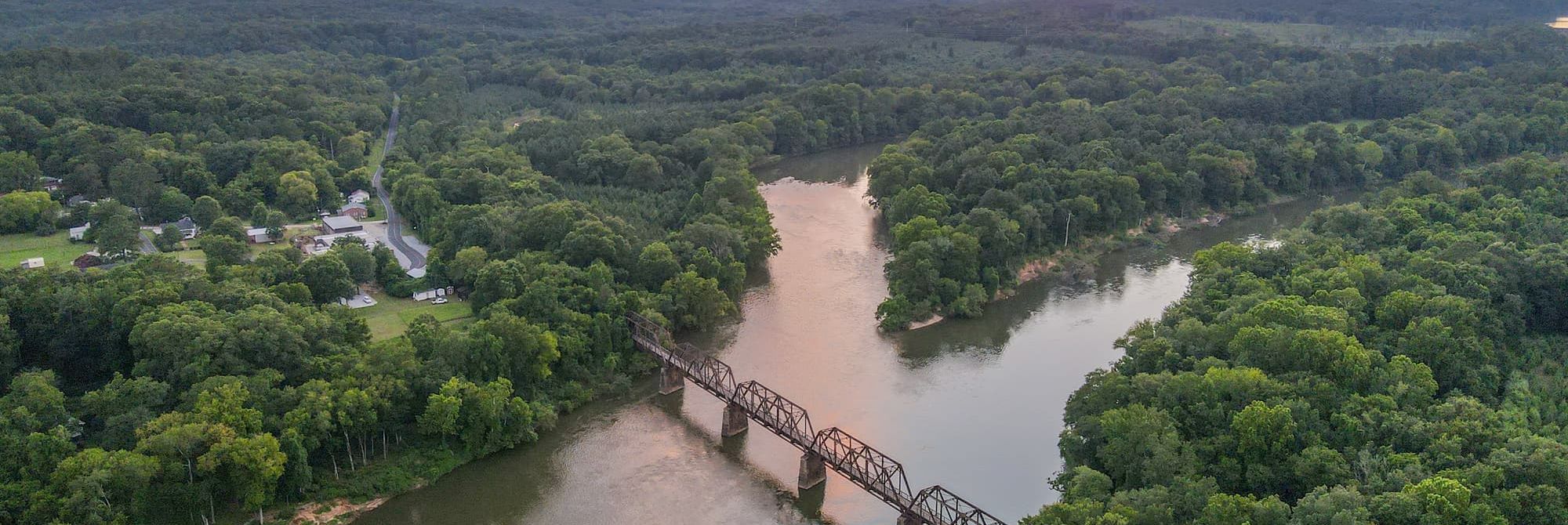About the Palmetto Trail
The Palmetto Trail began as the signature project of the Palmetto Conservation Foundation, a statewide nonprofit organization dedicated to protecting the natural environment and conserving South Carolina history and culture. Early leaders quickly realized that the most direct way to protect and conserve our natural and cultural legacy was to enable more people to experience it directly. Thus, the Palmetto Trail was born. Ground was broken on the first of the Trail’s passages, Lake Moultrie, in 1994 on land owned by Santee Cooper. Today the Trail includes several passages and will span 500-miles in total length when complete.
The Trail is a free public resource, serving residents and drawing tourists to the many small towns near trailheads. It provides an opportunity for active outdoor recreation, offers access to the state's spectacular beauty and rich history, and enhances economic development in our rural areas.
The Trail crosses state and county parks, national and state forests, nature preserves, Revolutionary War battlefields, a U.S. Army military post, and the steps of the State Capitol. The Palmetto Trail passages range from 1.1 to 47 miles in length and cover terrain from mountains to sandhills, piedmont to swamp. The Trail is recognized as a Federal Millennium Legacy Trail and together the Awendaw and Swamp Fox passages have been designated as a Recreational Trail American Trail System.
History of the Palmetto Trail
We began in 1989 when a small group of visionaries founded the Palmetto Conservation Foundation with the notion that making South Carolina's beautiful natural areas more easily available to the public would lead to greater conservation efforts. Sitting around a kitchen table, they realized that the opportunity to explore, appreciate and commune with nature was crucial to our well-being and that the best way to do so was on foot. They imagined a hiking trail stretching across the state from the mountains to the sea, connecting many of the state's treasured parks, forests, historical sites, and other special areas. The trail would be free and would encourage healthy, active recreation – the only equipment needed would be a pair of shoes. Since then …
- 1994 – Then-Governor Carroll Campbell included funding for the Trail in his executive budget request, ground was broken on the first passage, Lake Moultrie, on land offered by Santee Cooper.
- 1996 – The 24-mile Lake Moultrie passage was opened and the Trail began to take shape.
- 2002 – PCF established itself as the leading statewide trails and greenways organization.
- 2010 – Building on experience, PCF organized and hosted the first South Carolina Trails and Greenways conference which attracted more than 100 outdoor recreation professionals, advocates, and community leaders.
- 2013 – With funding from Boeing SC, PCF studied future needs for the Trail and published the "Palmetto Trail Statewide Master Plan." Based on a year's worth of input from stakeholders along the Trail, corporate and business partners, volunteers, the Board of Directors, and staff, the Master Plan details the strategy to "Finish the Trail."
- 2016 – The Palmetto Conservation Corps, South Carolina's only trail-based state AmeriCorps Program, is established. The Corps has been essential in meeting the expanding needs of the Trail – not just construction, but also maintenance and public education.
- 2021 – Health is explicitly linked to the recreational benefits of the Trail through an ongoing series of health screenings, guided trail walks, and the availability of fresh local produce.
- 2023 – Palmetto Trail becomes a key player in the newly created SC Trails Coalition, leading the statewide effort to unite trail managers across the state to share information about all our wonderful trail resources.
Once completed, the Palmetto Trail will span 500 miles, with many spur trails. The Trail passes through 14 counties and numerous towns, from Awendaw on the Intracoastal Waterway to Oconee State Park in the Blue Ridge Mountains. The Trail crosses state and county parks, national and state forests, nature and wildlife preserves, Revolutionary War battlefields, a U.S. Army military post, and the steps of the State Capitol. Several trail passages range from 1.1 to 47 miles long and cover terrain from mountains to sand hills, piedmont to swamp. Our focus has expanded beyond building new trails to include continual maintenance to keep the trail safe for all users. We are also teaching outdoor skills and enticing people to explore the Palmetto Trail and other natural areas in South Carolina. A wide array of outings, events, and new educational programs help people become more comfortable and familiar with the spectacular natural adventures the Palmetto State has to offer.
As we look ahead to the next 30 years of the Palmetto Trail, we are very grateful to those early visionaries, to the state for its support over the years, and our many donors and volunteers. We are excited to complete the Trail, add additional recreational amenities at select trailheads, and increase our health and educational offerings. We hope you will join us on this adventure.
The Palmetto Trail
Imagine 500 miles of cross-state hiking and bicycling paths beside lakes, across mountain ridges, through forests, into towns big and small, and across swamps:
- Showcasing conservation and preservation from mountains to sea
- Providing free public access to active, healthy outdoor recreation
- Fostering tourism, business, and economic development
The entire Palmetto Trail is open to hiking and backpacking. Designated passages and sites are available for mountain biking, horseback riding, and camping (see maps). The Trail cannot accommodate motorized vehicles.
Residents and visitors of all ages, abilities, and socioeconomic circumstances use the Palmetto Trail to enjoy nature, practice conservation, and learn history—all while being physically active. Traveled individually or together, the passages reveal the rich diversity and fascinating history, culture, and geography of the Palmetto State.
